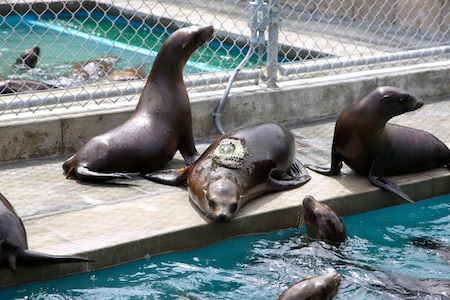
By Carisa Carlton, Special to the Independent
A die-off of starving sea lion pups in Southern California last year was partly caused by a change in their food supply as sardine spawning grounds shifted to deeper water, scientists announced Tuesday.
The findings come even as Laguna Beach’s Pacific Marine Mammal Center is again seeing an influx of malnourished, dehydrated sea lion pups with low body weight that is taxing the center’s capacity, said Keith Matassa, executive director of the only organization in the county federally licensed to retrieve and care for marine mammals.
So far this year PMMC has rescued 166 seal and sea lions and the marine mammal hospital is nearing capacity with 100 patients, a situation that closely mimics last year’s crisis. Then, over 370 marine mammals came ashore along Orange County’s coastline in 2013 in need of medical attention, PMMC spokeswoman Melissa Sciacca said in a statement.
In total, an unprecedented 1,600 California sea lions stranded alive along the Southern California coastline in the first four months of last year, which federal authorities declared an “unusual mortality event.” Under the Marine Mammal Protection Act of 1972, such a declaration is made when a stranding is unexpected, involves a significant die-off of any marine mammal population and demands immediate response.
The multi-disciplinarian team assembled to investigate the cause announced their tentative findings on a conference call with reports on Wednesday. A likely contributor to the strandings was a change in the pups food supply, scientists for the National Oceanic and Atmospheric Administration explained.
Sam McClatchie, supervisory oceanographer for the Southwest Fisheries Science Center, indicated that though sardine spawning distributions can shift inshore to offshore from one year to the next, they have been progressively shifting offshore for the past 15 years. “The sea lions are opportunistic feeders and so you shouldn’t get too fixated on the idea that all they’re feeding on is sardines, because that’s not correct,” McClatchie said.
Sarah Wilkin, marine mammal health and stranding response program coordinator in Washington, D.C., confirmed, however, that data shows sardine spawning grounds shifted offshore in 2012. “One of the forage species is sardines, which is known to be a high value food source, especially for the nursing mothers. And, our current data shows that sea lion forage was a contributor (to the strandings) but we still are investigating the exact mechanism of that.”
Sea lions prey on other fish, but those fish may not be as high in nutrition and fat as nursing sea lions require, she said.
Researchers also found various viruses, bacteria, and infectious agents in some of the pups, but the findings were inconsistent with a single epidemic or infectious disease.
The sea lion pups have a high rate of survival when rehabilitated. More than half of them survived and were released back into the ocean, said NOAA spokesman Jim Milbury in Long Beach.
Scientists are continuing to investigate the strandings by monitoring pup birth rate, strandings, infections, foraging of pups and mothers as well as changes in the spawning habitat of prey.
PMMC appealed to the public for assistance. “First and foremost, we need anyone who sees a seal or sea lion on the beach to back away and call us immediately,” Matassa said. “We have had a higher number of people chasing the animals back into the water or attempting their own rescues, which is the worst possible thing that can happen to a sick animal. These pups are coming ashore to get warm and rest, and need proper space to feel safe and unstressed.
“We encourage the public to keep their distance, call us to help identify the animal and location, and keep others away until we arrive. This will give us the best possible chance to assist these pups that need help,” he said.
Add PMMC to your contacts: 949 494-3050 to report the exact description and location of the animal.
Five-year resident Carisa Carlton writes the blog, Laguna Beach Gazette.




